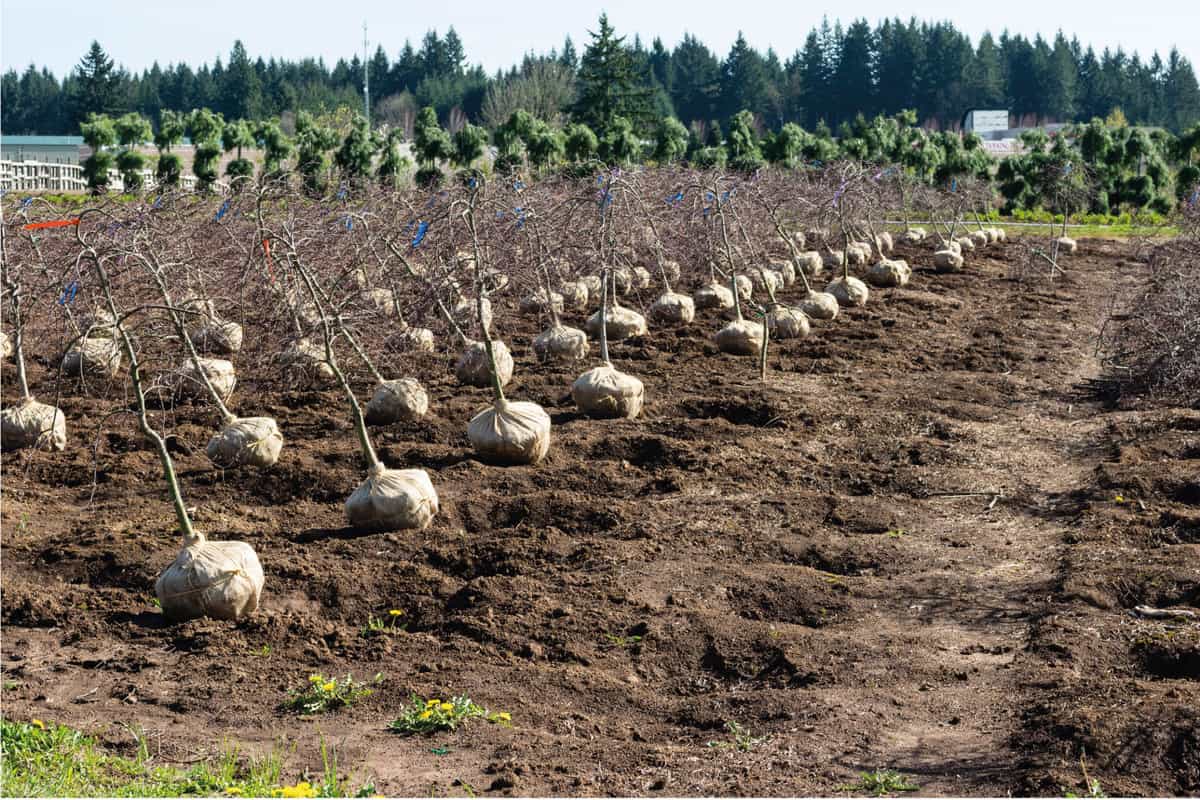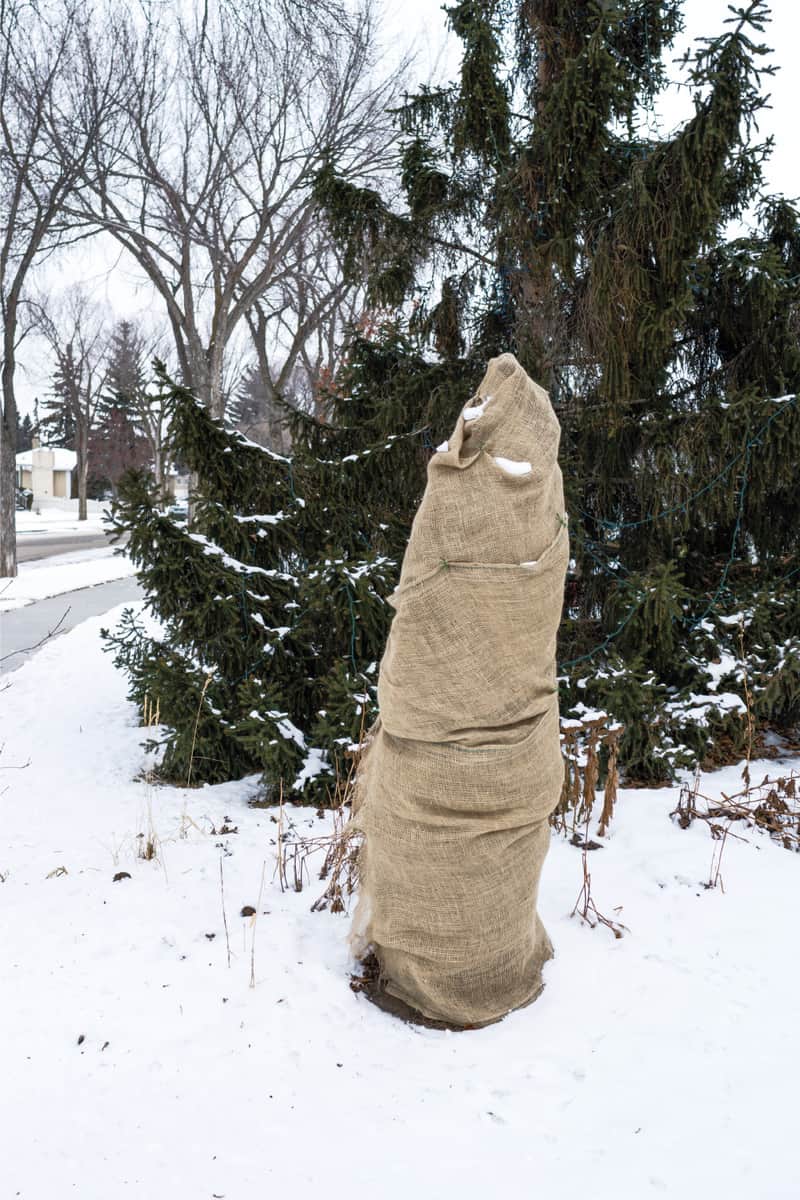If you're looking to plant some new trees in your yard, you may be considering purchasing some balled and burlapped trees. With their high survival rate and hardiness when taken care of correctly, it's a great option to consider when purchasing trees. However, for transportation or planting purposes, you may be wondering how much they weigh and how big they are. Well, we have done the research and have some answers for you.
The weight and size of a ball and burlapped tree will depend on the tree's caliper, height, and the type of soil it's planted in rather than the type of tree. The size of the ball can range from 2' to upwards of 7.5'. The weight of the tree can range from 100 lbs to over 1,000 lbs. Many nurseries will have a table showing how much their ball and burlapped trees weigh.
We've given you a wide range of weights to consider, but keep reading as we break this down into some examples. We'll also answer some other questions you might have about balled and burlapped trees, including how you can safely transport them.
![Ornamental trees with burlap wrapped root balls are ready for planting at an outdoor garden nursery. How Much Does A Balled And Burlapped Tree Weigh [By Tree Type And Size]](https://gardentabs.com/wp-content/uploads/2021/08/Ornamental-trees-with-burlap-wrapped-root-balls-ready-for-planting.-How-Much-Does-A-Balled-And-Burlapped-Tree-Weigh.png)
Balled And Burlapped Trees By Size
Why The Soil Affects The Weight
Balled and burlapped trees have to be grown in soil that will easily clump together, such as clay. It needs to clump together firmly around the roots to be easily wrapped with the burlap. Clay soil is heavy, which adds to the weight of the ball and burlapped root balls.

Weight By Tree Height or Caliper
Nurseries or landscaping companies will often list the weights of balled and burlapped trees by either the height of the tree or caliper. The caliper of the tree is the diameter of the trunk.
For example, Rost, Inc., a landscaping company in Missouri, has a simple table that lists the approximate weight of balled and burlapped trees. The table also lists the approximate size of the balls. For this company, they estimate the size ranging from 18" to 40" and the weight from 175 lbs to 1,200 lbs, respectively. However, they also state that the weight will vary depending on the soil type and moisture content.
Another company, We Find Plants, also has a PDF document listing the estimates of tree sizes. Their table estimates the size of the ball to be between 22" to 42" and the weight to be 200 lbs to 1,000 lbs, respectively. This isn't a drastic difference from Rost, Inc., so these two examples should be able to give you a rough idea of how heavy you might expect a balled and burlapped tree to be.
Can I move a B&B tree with my truck?

You may be wondering about the weights of B&B trees so you can calculate whether you can transport one in your truck. Balled and burlapped trees can be transported in the back of a pickup truck. Pickup trucks are able to hold a large payload. Payloads range from 3,000 lbs for a half-ton truck to 6,000 lbs for a one-ton truck.
How to safely move a B&B tree?
There's more to moving a B&B tree than just placing it in the back of your truck. If you can't have your B&B trees delivered by a professional, there are some other items you will need to bring with you to safely move your balled and burlapped tree.
Tie Downs
You will need to be able to secure the tree in the back of your truck. Be sure to take something to tie your tree down with. If the tree is not secured with tie-downs or rope, it can cause damage to the root ball and tree itself. You need to secure it as tight as possible, so it has no way of rolling around the truck bed.
Click here to see this tie down strap set on Amazon.
Mesh Tarps or Sheets
As we mentioned above, it is not only important to protect the root ball, but you need to avoid any damage to the trunk or foliage of the tree to ensure successful planting and growth. Kinsey Family Farm, a farm that sells balled and burlapped trees, suggests bringing mesh tarps or sheets to help protect the foliage of your tree. Mesh tarps or sheets allow for airflow.
Click here to see this heavy-duty mesh tarp on Amazon.
A Friend or Two
By now, you've probably realized that with the weight of the root balls, you probably won't be hauling the tree around yourself. You will need to bring someone with you to help you load the tree. Make sure to only move the tree by the root ball to ensure it doesn't get damaged.
If you got a B&B tree that is too heavy to lift out of the truck, Bookcliff Gardens, a landscaping company, recommends using a plank of wood to slide the tree down from the truck. The company states that allowing the tree to drop off of the truck without a ramp can cause the root ball to break. They also suggest backing your truck up as close as possible to the tree's planting location or using a wheelbarrow to move the tree to its destination.
Can you leave burlap on trees when planting?
Natural burlap will decompose, but a lot of burlap is treated or synthetic. Because of this, the burlap should be removed before planting. Not removing the burlap can cause problems for the tree later on.
USU's Forestry extension collected remarks from experts regarding whether the burlap should be removed. The majority agreed removing the burlap was necessary.
Some nurseries place the B&B trees in large wire baskets to make transportation easier. The wire baskets, if the holes are wide enough, should also be removed. Follow any planting instructions that come with your tree.
How long does burlap take to decompose?
Burlap, whether natural or synthetic, does not decompose quickly. It can take upwards of a decade to decompose. It is often assumed that natural burlap will rot quickly, but this is not the case. Burlaps slow rate of decay is why many experts recommend removing it before planting.
Why do you wrap a tree in burlap?

Burlap is used for rootballs because of its ability to absorb moisture while allowing airflow through its mesh design. It helps protect the roots during transportation. Burlap can also be used to protect trees during cold winters or heavy snowfall. In areas that see heavy snowfall, many evergreens will need to be wrapped to protect them.
To protect from heavy snowfall, trees are often covered in burlap. However, sometimes only the trunk of the tree needs wrapping. Wrapping the trunk of the tree during the winter months ensures the tree doesn't bloom early.
Click here to see Natural Burlap Fabric on Amazon.
Does burlap protect plants from frost?
Burlap does protect plants from frost. It is a good option for protecting plants from frost because it also allows the plants to breathe. You should cover any plants that you are unable to move inside. When using it to protect plants from frost, make sure the burlap reaches all the way to the ground.
For more reading about preparing plants for winter, check out some of our other blog posts:
How Do You Prepare a Banana Tree for Winter?
Should You Wrap Arborvitae For Winter?
Final Thoughts
Regardless of the size, balled and burlapped trees are heavy. Even the smallest tree can weigh over 100 lbs. Hopefully, our article has helped enlighten you on some of the possible sizes and weights of balled and burlapped trees. Just be sure to have help when you try to transport one! Happy planting!



